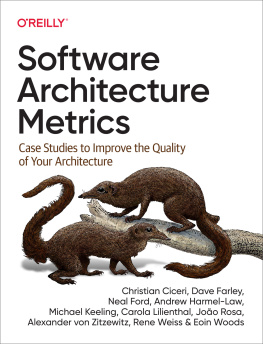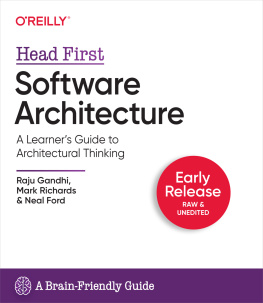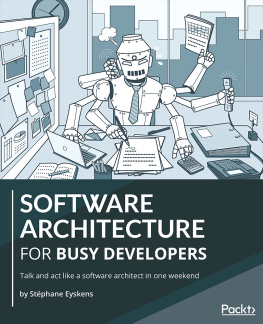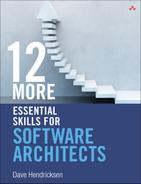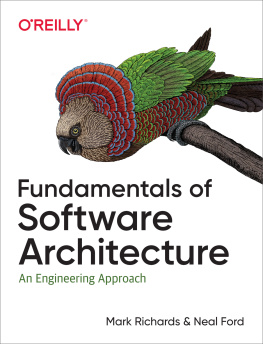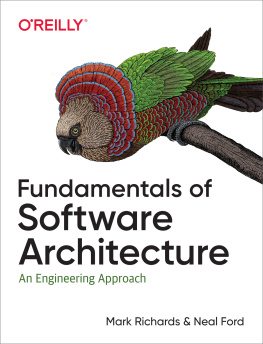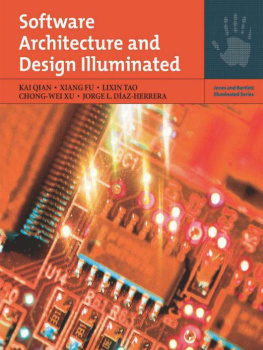Software Architecture Metrics
by Christian Ciceri , Dave Farley , Neal Ford , Andrew Harmel-Law , Michael Keeling , Carola Lilienthal , Joo Rosa , Alexander von Zitzewitz , Rene Weiss , and Eoin Woods
Copyright 2022 Apiumhub S.L. All rights reserved.
Printed in the United States of America.
Published by OReilly Media, Inc. , 1005 Gravenstein Highway North, Sebastopol, CA 95472.
OReilly books may be purchased for educational, business, or sales promotional use. Online editions are also available for most titles (http://oreilly.com). For more information, contact our corporate/institutional sales department: 800-998-9938 or corporate@oreilly.com.
- Acquisitions Editor: Melissa Duffield
- Development Editor: Sarah Grey
- Production Editor: Katherine Tozer
- Copyeditor: nSight, Inc.
- Proofreader: Sonia Saruba
- Indexer: Sue Klefstad
- Interior Designer: David Futato
- Cover Designer: Karen Montgomery
- Illustrator: Kate Dullea
Revision History for the First Edition
- 2022-05-18: First Release
See http://oreilly.com/catalog/errata.csp?isbn=9781098112233 for release details.
The OReilly logo is a registered trademark of OReilly Media, Inc. Software Architecture Metrics, the cover image, and related trade dress are trademarks of OReilly Media, Inc.
The views expressed in this work are those of the authors and do not represent the publishers views. While the publisher and the authors have used good faith efforts to ensure that the information and instructions contained in this work are accurate, the publisher and the authors disclaim all responsibility for errors or omissions, including without limitation responsibility for damages resulting from the use of or reliance on this work. Use of the information and instructions contained in this work is at your own risk. If any code samples or other technology this work contains or describes is subject to open source licenses or the intellectual property rights of others, it is your responsibility to ensure that your use thereof complies with such licenses and/or rights.
978-1-098-11223-3
[LSI]
Preface
Software architecture metrics are used to measure the maintainability and architectural quality of a software project, and to provide warnings early in the process about any dangerous accumulations of architectural or technical debt. In this book, 10 leading hands-on practitioners (Christian Ciceri, David Farley, Neal Ford, Andrew Harmel-Law, Michael Keeling, Carola Lilienthal, Joo Rosa, Alexander von Zitzewitz, Rene Weiss, and Eoin Woods) introduce key software architecture metrics that every software architect should know. The architects in this group have all published renowned software architecture articles and books, regularly participate in international events, and give practical workshops.
We all strive to balance theory and practice. This book, however, is not about theory; its about practice and implementation, about what has already been tried and has worked, with valuable experiences and case studies. We focus not only on improving the quality of architecture but on associating objective metrics with business outcomes in ways that account for your own situation and the trade-offs involved.
We conducted a survey and found that there is strong demand for software architecture metrics resources, yet very few are available. We hope this contribution will make a difference and help you set the right KPIs and measure the results accurately and insightfully.
We are grateful to the Global Software Architecture Summit, which reunited us and gave us the idea of writing a software architecture metrics book together. All of the books chapters and case studies are as different as the authors themselves: we made a point of using examples from different industries and challenges so that every reader can find a solution or an inspiration.
What Will You Learn?
By the end of this book youll understand how to:
Measure how well your software architecture is meeting goals
Guide your architecture toward testability and deployability
Prioritize software architecture work
Create predictability from observability
Identify key KPIs for your software project
Build and automate a metrics dashboard
Analyze and measure the success of your project or process
Build goal-driven software architecture
Who This Book Is For
This book is written by and for software architects. If youre eager to explore successful case studies and learn more about decision and measurement effectiveness, whether you work in-house for a software development company or as an independent consultant, this book is for you.
The 10 authors, all experienced practitioners, share their advice and wisdom, presenting diverse viewpoints and ideas. As you work on different projects, you might find some chapters more relevant to your work than others. You might use this book on a regular basis, or you might use it once to set the KPIs and then come back to it later to teach and inspire new team members.
Having the right software architecture metrics and tools can make architecture checking much faster and less costly. It can allow you to run checks throughout the life of a software project, starting right at the beginning. Metrics also help you evaluate your software architecture at each sprint to make sure its not drifting toward becoming impossible to maintain. They can also help you compare architectures to pick the one that best fits your projects requirements.
Conventions Used in This Book
The following typographical conventions are used in this book:
ItalicIndicates new terms, URLs, email addresses, filenames, and file extensions.
Constant widthUsed for program listings, as well as within paragraphs to refer to program elements such as variable or function names, databases, data types, environment variables, statements, and keywords.
OReilly Online Learning
Note
For more than 40 years, OReilly Media has provided technology and business training, knowledge, and insight to help companies succeed.
Our unique network of experts and innovators share their knowledge and expertise through books, articles, and our online learning platform. OReillys online learning platform gives you on-demand access to live training courses, in-depth learning paths, interactive coding environments, and a vast collection of text and video from OReilly and 200+ other publishers. For more information, visit https://oreilly.com.
How to Contact Us
Please address comments and questions concerning this book to the publisher:
- OReilly Media, Inc.
- 1005 Gravenstein Highway North
- Sebastopol, CA 95472
- 800-998-9938 (in the United States or Canada)
- 707-829-0515 (international or local)
- 707-829-0104 (fax)
We have a web page for this book, where we list errata, examples, and any additional information. You can access this page at https://oreil.ly/software-architecture-metrics.
Email to comment or ask technical questions about this book.
For news and information about our books and courses, visit https://oreilly.com.
Find us on LinkedIn:

